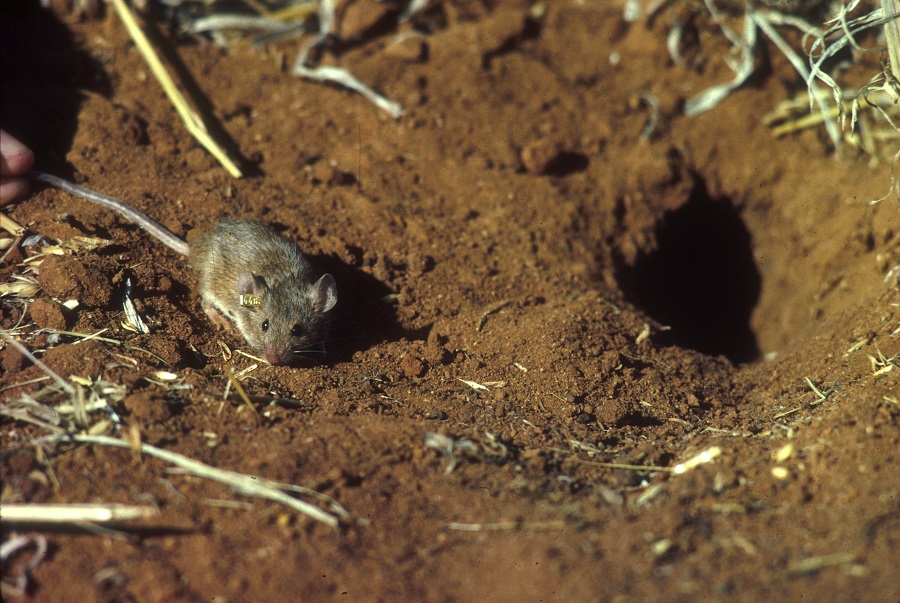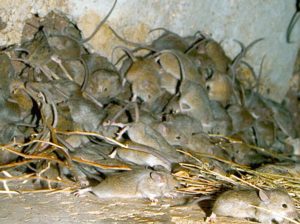Mice began breeding a couple weeks early this spring, so our experts are anticipating a plague by autumn. But how can two weeks make such a difference? And are mice really that big a problem?

A single mouse near its burrow
The original Modest Mouse is more into the soothing sounds of Barry White
Everyone loves a good old-fashioned mouse plague, right? Oh yeah, no we don’t. Not at all.
Well, if you’re in Victoria or South Australia grab some steel wool and get the house ready because our experts are expecting a lot of mice this autumn.
Why so many?
There are a few reasons why certain years are better than others for the humble mouse. Our ecologist Steve Henry explained how three key factors can contribute to a plague: climate, food and breeding.
“Their breeding season usually starts in late August or September, but this year we found it started in early August. This is most likely because we’ve had one of the wettest springs on record which led to a terrific harvest, meaning more food for mice,” Mr Henry said.
Because mice aren’t spending all their time hunting for food, they have time to get down to business and procreate. Two or three weeks early doesn’t sound like a big deal, but those extra weeks can have a massive impact.
“By the time I got to my first site, three generations had already been born,” he said.
To put that in perspective, a single breeding pair of mice can produce up to 500 offspring in a breeding season (spring to summer). It takes mice only six weeks to reach maturity and their gestation period is about 19 to 21 days.
“They even get pregnant as soon as they’ve given birth, so they’re gestating a new litter while weaning their current one.
And unless summer brings lots of very hot, dry weather (we’re looking at you, Melbourne), they’ll continue breeding right through. So in autumn, when farmers begin sowing their next crop and the weather is again favourable for breeding, there’ll be a greater ‘base’ population of mice ready to procreate.
Why so serious?

A plague of mice
Two mice becomes 500 mice pretty quickly in the right conditions.
Spreading disease aside, mice do much more than run about leaving droppings everywhere.
In 1993, Australia’s worst ever mouse plague caused an estimated $96 million worth of damage, destroyed thousands of hectares of crops, blighted piggeries and ravaged poultry farms. The whiskered marauders chewed their way through rubber and electrical insulation, damaged farm vehicles, ruined cars and buildings.
Another plague in 2010/11 was almost as bad, affecting 3 million ha of crops in NSW’s central west and the Riverina, as well as parts of Victoria and South Australia.
So what can you do about it?
The good news is that with sufficient warning it is possible to prepare for mouse plagues, and to minimise the damage they cause, through early baiting and removing food supplies and cover. But as well as reducing numbers, our researchers are urging everyone to make use of MouseAlert, a citizen science website where keen-eyed rodent reporters can notify us about mouse sightings, enabling us to better track their numbers and help communities prepare.
So if you see a mouse, don’t stay silent, report it before putting steel wool in all the nooks and crannies of your home!


22nd January 2017 at 11:27 am
This is nothing compared to the human plague which, will end the same way that all plagues do.
Cheers.
21st January 2017 at 4:10 pm
Rats also are a big deal for farms like ours in WA’s southwest. Luckily, the feral cats hereabouts have been knocking off everything including the rabbits, so the rats & mice have a challenge. And the snakes love the rats & rarely bother us. Great thing about feral cats is we don’t have to feed them & they daren’t come into the house enclosure because of our dogs, so we have plentiful small bird life everywhere in the garden. Cheers.